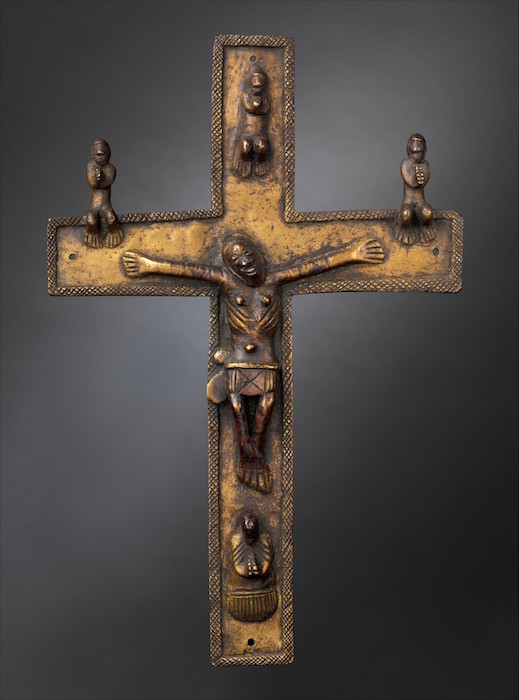The Crucifix - Historical African Art

The Crucifix
https://smarthistory.org/historical-overview/
Dr. Christa Clarke, "Historical overview: to 1600," in Smarthistory, September 21, 2016, accessed November 2, 2021, https://smarthistory.org/historical-overview/.
This piece is titled “Crucifix.” To the left you see a cross. This cross is a 16th-17th century art piece from Africa. It is more specifically from the Democratic Republic of Congo. It was created by the Kong peoples. It is a solid cast brass piece, and it stands about 27.3 cm tall. The cross has many visible details. The cross itself is a gold brassy color, with what seems to be a lot of tarnishing. It could also be painted gold, and the paint is wearing off. Either way, they both shows signs of aging. The cross has a cross—hatching design wrapped along the edges of each side. On each point of the cross you see a small black dot as well. The next key feature is the people on the cross. There is one primary figure that draws the eye in right away. This figure has their arms spread out in a T-pose, and their head is tilted to the left. Their facial expressions are flat and emotionless. Their body seems to be weak and famished, as you can see the lines which represent ribs. The figure is only wearing wrapping around their waist, and the cloth is designed. The figure’s legs are hanging down. It seems this figure is pinned to the cross. Around the person is four smaller figures. Two are sitting on the left and right wing of the cross, and the other two are on the top point and the very bottom point. The two depicted at the apex and base. Are kneeling, and the two sit comfortably on either side of the arms of the cross. These little figures are praying, and I am assuming they are praying to the middle figure. This piece heavily relates to Christianity, which was introduced to the Republic of Congo around early 16th century. Most people know the story of the crucifixion from Christianity. In this piece, however, the Christ figure has African features. This makes sense because each figure of Christ in each religion/culture is different. The creator of this piece transformed the Western prototype that served as its model. Meaning the creator changed the stereotypical “Western Christ”, and made it more subject to the African Culture.
Comments
Post a Comment